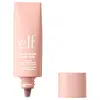What's inside
What's inside
 Key Ingredients
Key Ingredients

 Benefits
Benefits

 Concerns
Concerns

 Ingredients Side-by-side
Ingredients Side-by-side

Zinc Oxide 12%
Cosmetic ColorantWater
Skin ConditioningC12-15 Alkyl Benzoate
AntimicrobialIsododecane
EmollientLauryl PEG-8 Dimethicone
Tridecyl Salicylate
Skin ConditioningCalcium Sodium Borosilicate
Propanediol
SolventButyloctyl Salicylate
Skin ConditioningCaprylyl Methicone
Skin ConditioningDimethicone
EmollientNiacinamide
SmoothingC13-15 Alkane
SolventSilica
AbrasiveOctyldodecyl Neopentanoate
EmollientPolyglyceryl-2 Dipolyhydroxystearate
Skin ConditioningPolyglyceryl-3 Polyricinoleate
EmulsifyingSodium Chloride
MaskingDisteardimonium Hectorite
StabilisingPhenoxyethanol
PreservativeBisabolol
MaskingLecithin
EmollientCaprylyl Glycol
EmollientAllantoin
Skin ConditioningEthylhexylglycerin
Skin ConditioningHexylene Glycol
EmulsifyingPolyglyceryl-4 Diisostearate/Polyhydroxystearate/Sebacate
EmulsifyingHydrogenated Lecithin
EmulsifyingTetrasodium Glutamate Diacetate
Aluminum Hydroxide
EmollientSodium Hydroxide
BufferingCI 77891
Cosmetic ColorantCI 77491
Cosmetic ColorantCI 77492
Cosmetic ColorantCI 77499
Cosmetic ColorantZinc Oxide 12%, Water, C12-15 Alkyl Benzoate, Isododecane, Lauryl PEG-8 Dimethicone, Tridecyl Salicylate, Calcium Sodium Borosilicate, Propanediol, Butyloctyl Salicylate, Caprylyl Methicone, Dimethicone, Niacinamide, C13-15 Alkane, Silica, Octyldodecyl Neopentanoate, Polyglyceryl-2 Dipolyhydroxystearate, Polyglyceryl-3 Polyricinoleate, Sodium Chloride, Disteardimonium Hectorite, Phenoxyethanol, Bisabolol, Lecithin, Caprylyl Glycol, Allantoin, Ethylhexylglycerin, Hexylene Glycol, Polyglyceryl-4 Diisostearate/Polyhydroxystearate/Sebacate, Hydrogenated Lecithin, Tetrasodium Glutamate Diacetate, Aluminum Hydroxide, Sodium Hydroxide, CI 77891, CI 77491, CI 77492, CI 77499
Zinc Oxide 20%
Cosmetic ColorantAloe Barbadensis Leaf Juice
Skin ConditioningCocos Nucifera Oil
MaskingPyrus Malus Juice
Skin ConditioningVitis Vinifera Juice
AntioxidantCaprylic/Capric Triglyceride
MaskingSorbitan Stearate
EmulsifyingRicinus Communis Seed Oil
MaskingPolyglyceryl-10 Laurate
Skin ConditioningMagnesium Sulfate
Helianthus Annuus Seed Oil
EmollientSimmondsia Chinensis Seed Oil
EmollientTocopherol
AntioxidantMagnesium Ascorbyl Phosphate
AntioxidantSodium Hyaluronate
HumectantMalus Domestica Fruit Cell Culture Extract
Skin ConditioningVitis Vinifera Fruit Cell Extract
Skin ConditioningCitrus Limon Leaf Cell Extract
Skin ConditioningPhenethyl Alcohol
MaskingEthylhexylglycerin
Skin ConditioningCitrus Reticulata Peel Oil
MaskingCitrus Aurantium Peel Oil
Iron Oxides
Zinc Oxide 20%, Aloe Barbadensis Leaf Juice, Cocos Nucifera Oil, Pyrus Malus Juice, Vitis Vinifera Juice, Caprylic/Capric Triglyceride, Sorbitan Stearate, Ricinus Communis Seed Oil, Polyglyceryl-10 Laurate, Magnesium Sulfate, Helianthus Annuus Seed Oil, Simmondsia Chinensis Seed Oil, Tocopherol, Magnesium Ascorbyl Phosphate, Sodium Hyaluronate, Malus Domestica Fruit Cell Culture Extract, Vitis Vinifera Fruit Cell Extract, Citrus Limon Leaf Cell Extract, Phenethyl Alcohol, Ethylhexylglycerin, Citrus Reticulata Peel Oil, Citrus Aurantium Peel Oil, Iron Oxides
 Reviews
Reviews

Ingredients Explained
These ingredients are found in both products.
Ingredients higher up in an ingredient list are typically present in a larger amount.
Ethylhexylglycerin (we can't pronounce this either) is commonly used as a preservative and skin softener. It is derived from glyceryl.
You might see Ethylhexylglycerin often paired with other preservatives such as phenoxyethanol. Ethylhexylglycerin has been found to increase the effectiveness of these other preservatives.
Zinc Oxide is a mineral broad-spectrum UV filter; it is the broadest UVA and UVB reflector approved by the FDA. It also has skin protectant and skin soothing properties.
Zinc oxide is one of the most effective broad-spectrum UV filters. It protects against UVB, UVAII, and UVAI. In comparison to its counterpart titanium dioxide, zinc oxide provides uniform and extended UVA protection.
Another great benefit? This ingredient is highly photostable so it won't degrade easily under sunlight.
A common myth is that mineral UV filters are widely believed to primarily reflect UV light.
However, modern research shows titanium dioxide absorbs UV radiation like chemical filters (~95% absorption & 5% reflection).
Zinc oxide has great skin soothing properties so you'll likely find this in sunscreens formulated for sensitive skin or babies/children. It is unlikely to cause "eye sting" like other sunscreen ingredients.
Regulatory agencies consider zinc oxide to be non-toxic and safe. It has also been shown to not penetrate the skin.
Unfortunately, this ingredient does leave a visible white cast. This is why mineral sunscreens are often less cosmetically elegant than chemical or hybrid ones.
In cosmetics, zinc oxide can be found in both non-nano and nano-sized forms. The nano version is used to reduce white cast and improve the texture of sunscreen formulas.
There are ongoing concerns surrounding nano-zinc oxide's impact on marine ecosystems and whether it can be absorbed into skin.
Regarding marine ecosystems and coral reefs, there is no conclusive evidence that any form of zinc oxide (or any other sunscreen ingredients) will cause harm. The science is still developing but many consumers are keeping a close eye on this issue.
Please note, many destinations have reef-safety sunscreen rules. For instance, the U.S. Virgin Islands advises all visitors to use non-nano mineral sunscreens.
There has also been some stir about whether micronized or nano zinc oxide has potential photoxicity and absorption through the skin/lungs.
An in-vitro (done in a test tube or petri dish) study demonstrated micronized zinc oxide to have potential phototoxicity. There's no need to fret; the EU Commission's Scientific Committee on Consumer Safety has stated, "The relevance of these findings needs to be clarified by appropriate investigations in vivo." Or in other words, further studies done on living organisms are needed to prove this.
Current research shows zinc oxide nanoparticles do not penetrate intact or sunburned skin. They either remain on the surface or in the outermost layer of dead skin (stratum corneum).
Zinc oxide is one of only two classified mineral UV filters with titanium dioxide being the other one.
Fun fact: Zinc has been used throughout history as an ingredient in paint and medicine. An Indian text from 500BC is believed to list zinc oxide as a salve for open wound. The Ancient Greek physician Dioscorides has also mentioned the use of zinc as an ointment in 1AD.
Learn more about Zinc Oxide